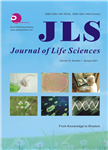Hormonal (Thyroxin, Cortisol) and Immunological (Leucocytes) Responses to Cistern Size and Heat Stress in Tunisia
Hormonal (Thyroxin, Cortisol) and Immunological (Leucocytes) Responses to Cistern Size and Heat Stress in Tunisia作者机构:Ressources Animales Halieutiques et Technologie Alimentaire Institut National Agronomique de Tunisie Tunis 1082 Tunisie Production Animale Institut Supdrieur de Biologie Appliquee de Medenine Medenine 4100 Tunisie CoRFiLaC Regione Siciliana Ragusa 97100 Italy
出 版 物:《Journal of Life Sciences》 (生命科学(英文版))
年 卷 期:2011年第5卷第5期
页 面:332-338页
学科分类:090502[农学-动物营养与饲料科学] 090602[农学-预防兽医学] 0905[农学-畜牧学] 09[农学] 0906[农学-兽医学]
主 题:Heat stress cistern size cortisol thyroxin lymphocytes.
摘 要:This study was designed to determine the effects of heat stress on plasma leucocytes, Thyroxin (T4) and cortisol concentrations in dairy cows with small and large cistern under hot climate. This experiment was carried out in 2006, in North Tunisia, using a randomized block design per udder cistern size, using 60 Holstein cows. Cows were classified according to udder cistern size by ultrasonography as large-cisterned (44 ±13 cm2; LC) and small-cisterned (21 ± 8 cm2; SC). The experiment was carried out in two different periods: spring (Apr. 5 (D1)) and summer (July 19 (D2), Aug. 19 (D3) and Sept. 19 (D4)). On each test day, temperature and relative humidity data were registered hourly and cows' blood was sampled from the jugular vein to determine serum concentrates of cortisol and T4. Leucocytes (lyrnphocytes, eosinophils, neutrophils and monocytes) were counted differentially, and percentages of lymphocytes relative to total counted cells were calculated. Mean temperature-humidity index (THI) values were 62 ±2, 79 ±2, 84 ±2, and 77 ±1 in DI, D2, D3, and D4, respectively. Lymphocyte incidence relative to total cell counts and T4 concentrations were affected by test day (P 〈 0.001). Lymphocytes (%) were significantly less in hotter months. During summer, T4 concentration at D2 (87.4 nmol/L) was higher relative to concentrations at D3 (42.8 nmol/L) and D4 (53.5 nmol/L). T4 concentrations were higher (P 〈 0.01) in SC cows (67.7 ±0.1 nmol/L) compared to LC cows (52.7 ±0.1 nmol/L). Cortisol concentration was effected neither by test day nor by cistern size. However, the decrease of lymphocyte concentration during summer compared to spring could be considered as an evidence of the suppression of cows' immune system under heat stress.



